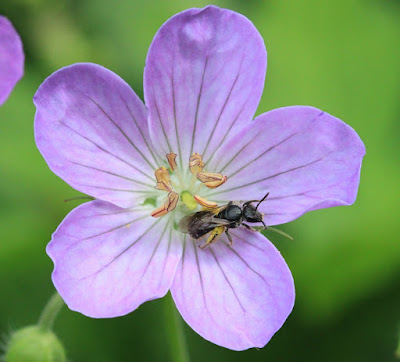 |
| Lasioglossum pectorale (Smith, 1853)
Gibbs, Rightmyer & Isaacs, 2017
|
Abstract
The state of Michigan occupies an area between the Great Plains and the northeastern United States, bordering four Great Lakes, with diverse biogeographical regions. Michigan also has the second most diverse agriculture in the country, with many crops that depend on bees for pollination. This unique combination provides a wide range of opportunities for bees to persist, yet there is no current published checklist of these important insects. This study was conducted to provide the first annotated checklist of the bee (Apoidea: Anthophila) fauna of Michigan, summarizing aspects of their taxonomy and behavior and to provide provisional conservation assessment. The list was compiled from a critical review of published literature, museum specimens, and database records, supplemented by new collections. In total, 465 species are included in the checklist, including 38 new records, however evidence for 13 species is poor, several more species require taxonomic revision, and the presence of additional species is expected. The exotic megachilid species Megachile apicalis Spinola, M. pusilla Pérez (=concinna Smith, auct.) and Osmia taurus Smith are reported from Michigan for the first time. New state records of native species include Anthidium tenuiflorae Cockerell and Nomada alpha alpha Cockerell, both previously undocumented from eastern North America, and Nomada sphaerogaster Cockerell, which has rarely been recognized. The taxonomy of some bee species is clarified by the formal publication of 11 new synonymies (some previously reported online or in manuscripts). The following list cites junior synonyms first followed by the valid name: Andrena chippewaensis Mitchell 1960 = A. (Simandrena) wheeleri Graenicher 1904; Osmia hendersoni Cockerell 1907 = O. (Melanosmia) tarsata Provancher 1888; Osmia michiganensis Mitchell 1962 = O. (M.) subarctica Cockerell 1912 (new status, removed from synonymy with O. (M.) tersula Cockerell 1912); Sphecodes persimilis Lovell and Cockerell 1907 = S. davisii Robertson 1897; Sphecodes knetschi Cockerell 1898 = S. dichrous Smith 1853; Sphecodes carolinus Mitchell 1956 = S. coronus Mitchell 1956; Sphecodes stygius Robertson 1893 = S. mandibularis Cresson 1872; Sphecodes prostygius Mitchell 1960 = S. fattigi Mitchell 1956; Stelis vernalis Mitchell 1962 = S. coarctatus Crawford 1916; and Stelis michiganensis Mitchell 1962 = S. foederalis Smith 1854. Poorly known Andrena (Cnemidandrena) are discussed, including A. parnassiae Cockerell, a new state record, A. robervalensis Mitchell, and the extralimital A. runcinatae Cockerell. Of these, only A. robervalensis was considered in the subgeneric revision, but we recognize all three as valid species pending further study. Nomada binotata (Robertson 1903) and N. quadrimaculata (Robertson 1903) are removed from synonymy with N. ovata (Robertson 1903), based on examination of the lectotypes. A new species, Triepeolus eliseae Rightmyer, the eastern representative of the verbesinae species group, is described. A putative undescribed species, Osmia aff. trevoris, is documented, but requires additional study for its status to be fully resolved. A rich bee fauna is documented that includes geographically-restricted species, rare and regionally-declining species, and economically-important species, providing information for ongoing conservation planning and future analysis of trends in bee populations.
Keywords: Hymenoptera, check list, faunal list, new species, nomenclature, pollinators, synonymies
Jason Gibbs, Molly G. Rightmyer and Rufus Isaacs. 2017. The Bees of Michigan (Hymenoptera: Apoidea: Anthophila), with Notes on Distribution, Taxonomy, Pollination, and Natural History. Zootaxa. 4352(1); 1-160. DOI: 10.11646/zootaxa.4352.1.1
